![]()
![]()
![]()
Use LEFT and RIGHT arrow keys to navigate between flashcards;
Use UP and DOWN arrow keys to flip the card;
H to show hint;
A reads text to speech;
182 Cards in this Set
- Front
- Back
- 3rd side (hint)
|
Flexibility |
The normal extensibility of all soft tissues but allow for for ROM of a joint. |
|
|
|
Extensibility |
Capability to be elongated/stretched. |
|
|
|
An important characteristic of soft tissue is that it will only achieve efficient extensibility if |
Optimal control of movement is matin throughout the entire ROM. |
|
|
|
Dynamic ROM |
The combination of flexibility & the NS‘s ability to control this ROM efficiently. |
|
|
|
What are the various factors that can influence flexibility? |
Genetics Connective tissue elasticity Composition of tendons/skin surrounding the joint. Joint structure Strength of opposing muscle groups. Body comp sex Age Activity level Previous injuries/existing medical issues. Repetitive movements (pattern overload). |
There are 12 |
|
|
Neuromuscular efficiency |
The ability of the NMS to allow agonist, antagonist, & stabilizers to work synergistically to reduce, reduce, & dynamically stabilize the entire kinetic chain and all 3 planes of motion. |
|
|
|
Concentric actions |
Produce force. |
|
|
|
Eccentric actions |
Reduce force |
|
|
|
Isometric when performing a cable pulldown exercise, the latissimus dorsi agonist must be able toTo allow for optimal neuromuscular efficiency, individuals must have proper actions |
Dynamically stabilize. |
|
|
|
To allow for optimal neuromuscular efficiency, individuals must have proper |
Flexibility in all three planes of motion |
|
|
|
Multiplan of flexibility : muscle, plane of motion, movement : |
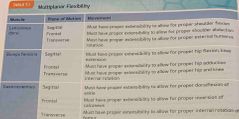
Back (Definition) |
|
|
|
Postural distortion (Poor static/dynamic posture) |
Predictable patterns of muscle imbalances. |
Can lead to decreased NM efficiency & tissue overload. |
|
|
Postural distortion patterns (Poor static/dynamic posture) are represented by a lack of |
Structural integrity, resulting from decreased functioning of one (or more) components of the HMS. |
|
|
|
A lack of structural integrity can result in |
Altered length-tension relationships (altered muscle lengths) altered force-couple relationships (altered muscle activation) Altered arthrokinematics (altered joint motion) |
|
|
|
Maximal NM efficiency of the HMS can only exist if |
All components (muscular, skeletal, & neural) function optimally & interdependently. |
|
|
|
The ultimate goal of the HMS is to maintain |
Homeostasis (dynamic postural equilibrium) |
|
|
|
Poor flexibility can lead to the development of |
Relative flexibility (altered movement patterns). |
|
|
|
Relative flexibility (altered movement patterns) |
The tendency of the body to seek the path of least resistance during functional movement patterns. |
|
|
|
And example of relative flexibility with the people who |
Flat with your feet externally rotated, this is because of tight calf muscles and the lack of proper dorsiflexion at the ankle. |
|
|
|
Another example of relative flexibility can be seen when people perform in 0H shoulder press with |
Excess of lumbar extension arched lower back, they possess a tight latissimus dorsi & have decreased sagittal plane shoulder flexion. |
|
|
|
Muscle imbalance |
Alteration of muscle lengths surrounding a joint. |
|
|
|
Overactive muscle and balances... |
Force compensation to occur. |
|
|
|
Underactive muscle imbalances... |
Allow for the compensation to occur. |
|
|
|
What are the variety of mechanisms that can cause a muscle imbalance? |
Postural stress Emotional duress Repetitive movement Cumulative trauma Poor training technique Lack of core strength Lack of NM efficiency |
|
|
|
Muscular imbalance chart |
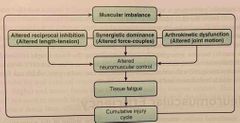
Back (Definition) |
|
|
|
Reciprocal inhibition |
The simultaneous contraction of 1 muscle in the relaxation of its antagonist to allow movement to take place. |
|
|
|
An example of reciprocal inhibition would be performing elbow flexion during a biceps curl. |
The biceps brachii actively contracts while the triceps brachii (the antagonist) relaxes to allow the movement to occur. |
|
|
|
Altered reciprocal inhibition |
The concept of muscle in addition, caused by a tight agonist, inhibiting its functional antagonist. |
|
|
|
An example of an altered reciprocal inhibition is a tight psoas hip flexor |
decreasing in a neural drive of the gluteus maximus (hip extensors) |
|
|
|
Force couple relationship |
Force couple relationship Produces synergistic dominance Leads to development of faulty movement patterns, poor NM control, and arthrokinetic dysfunction. |
|
|
|
Prolonged golgi tendon organ stimulation provides |
And inhibitory action to muscle spindles (located within the same muscle). |
|
|
|
Autogenic inhibition |
Neural impulses that sense tension are greater than the impulses that caused the muscle to contract, providing an inhibitory effect to the muscle spindles. |
|
|
|
Flexibility training is a key component for all training programs it is used for : |
Correcting muscle imbalances Increasing joint ROM Decreasing the excessive tension of muscles. Relieving joint stress Improving the extensibility of the musculotendinious junction. Maintaining the normal functional length of all muscles. Improving NM efficiency Improving function |
|
|
|
Pattern overload |
Consistently repeating the same pattern of motion, placing abnormal stress on the body. |
(Baseball pitching, long-distance running, cycling) |
|
|
Cumulative injury cycle |
Is a repair process caused when poor posture & repetitive movements create dysfunction within the connective tissue of the body which is treated like an injury. |
|
|
|
Inflammation activates the bodies pain receptors, initiating |
a protective mechanism, increasing muscle tension or causing muscle spasms. |
|
|
|
Heightened activity of muscle spindles in particular areas of the muscle create a |
Microspasm, causing adhesions (knots) to begin to form in the soft tissue. |
|
|
|
Adhesions form a week, and elastic matrix in ability to stretch that decreases |
Normal elasticity of soft tissue. |
|
|
|
The decrease of normal elasticity of soft tissue results in |
Altered link tension relationships (leading to altered reciprocal inhibition). Altered force couple relationships (leading to synergistic dominance). Arthro-kinetic dysfunction (leading to alter joint motion). |
|
|
|
If the adhesions are left untreated they can begin to form |
Permanent structural changes and soft tissue that is evident by Davis’s law. |
|
|
|
Synergistic dominance |
The NM phenomenon that occurs when inappropriate muscles take over the function of a weak/inhibited a primer. |
|
|
|
Davis’s law |
Soft tissue models along the lines of stress. |
|
|
|
Soft tissue is remodeled rebuilt with an |
inelastic collagen Matrix that forms in a random fashion. |
It does not run in the same direction as the muscle fibers. |
|
|
If the muscle fibers Arlington, these in elastic connective tissue fibers act as |
Roadblocks, preventing the muscle fibers from moving properly, creating alterations in normal tissue extensibility & causing relative flexibility. |
|
|
|
Muscles and a constant shortened State (hip flexor musculature when sitting for prolonged periods everyday) It will demonstrate |
Poor NM efficiency (as a result of altered length tension & force couple relationships). |
|
|
|
Muscles in a constant shortened state will affect |
Joint motion (ankle, knee, hip, & lumbar spine) & alter movement patterns (leading to synergistic dominance). |
|
|
|
And inelastic collagen matrix will form along |
The same lines of stress created by altered muscle movements. |
|
|
|
Because the muscle is consistently shortened in the pattern different from its intended function, the new form in elastic connective tissue forms |
Along this altered pattern, reducing the ability to extend and moves in its proper manner. |
|
|
|
What are the 3 phases of integrated flexibility continuum training within the OPT model? |
Collective Active Functional |
|
|
|
Flexibility techniques should only be performed |
Tissues that have been identified as overactive (tight) during the assessment process. |
|
|
|
Correct the flexibility is designed to |
Increase joint ROM Improve muscle imbalances Correct altered joint motion |
|
|
|
And example of synergistic dominance is if the psoas it’s tight, it leads to |
Altered reciprocal inhibition of the gluteus max, increased force output of the synergists for hip extension (hamstring complex, adductor Magnus) to compensate for the weakened gluteus max. |
|
|
|
Corrective exercise includesSelf myofascial release uses the principle |
Self myofascial release Static stretching |
|
|
|
Self myofascial release uses the principle of |
Autogenic in addition to cause muscle relaxation. |
|
|
|
Static stretching can use either |
Autogenic inhibition or reciprocal inhibition to increase muscle length depending on how the stretch is performed. |
|
|
|
Corrective flexibility is appropriate at what level of the OPT model? |
Stabilization level (phase 1) |
|
|
|
At the flexibility uses |
Self myofascial release Active isolated stretching techniques |
|
|
|
Active isolated stretching is designed to improve the |
Extensibility of soft tissue & increase NM efficiency by using reciprocal inhibition. |
|
|
|
Active isolated stretching allows forAnd example of active isolated stretching would be |
Agonists & synergist muscles to move a limb through full ROM while the functional antagonists are being stretched. |
|
|
|
An example of active isolated stretching would be |
A supine straight leg raise. It uses the hip flexors and quadriceps to raise the lake and hold it unsupported, the antagonist hamstring complex is stretched. |
|
|
|
Active flexibility would be appropriate at what level of the OPT model? |
Strength level (phases 2, 3, & 4) |
|
|
|
Self myofascial release techniques Dynamic stretching |
Self myofascial release techniques Dynamic stretching |
|
|
|
The results of synergistic dominance is |
Faulty movement patterns, leading to arthrokinetic dysfunction & eventually injury. |
|
|
|
Dynamic stretching requires |
Integrated, multiplantar soft tissue extensibility, with optional NM control, through full ROM. |
essentially movement without compensations. |
|
|
If a client is compensating when performing dynamic stretches during training, then they need to be |
Regressed to active or corrective flexibility. |
|
|
|
Functional flexibility would be appropriate at what level of the OPT model?Or functional movements occur in |
Power level (phase 5) |
Before athletic competition this would be used. |
|
|
I’ll functional movements occur in |
All 3 planes of motion. |
|
|
|
Transfers |
Transverse |
|
|
|
If the appropriate soft tissue was not extensive all through the fall ROM, the risk of injury |
Dramatically increases. |
|
|
|
The flexibility continuum is a |
Systematic progression |
|
|
|
Arthro-kinetic dysfunction |
Altered forces at the joint that results in abnormal muscular activity & impaired NM communication at the joint. |
|
|
|
Altered joint motion can be caused by |
Altered length tension/force couple relationship couples, affecting the joint and causing poor movement efficiency. |
|
|
|
And example of Arthur Connecticut Passion is performing a squat with excessively externally rotated feet |
This forces the tibia (shin bone) & femur to also rotate externally. |
|
|
|
Mechanoreceptors (sensory receptors) located in the muscles & The hamstring complex is a prime example of tendons help to |
Determine muscle balance or imbalance. |
|
|
|
The hamstring complex is a prime example of the muscle spindles response to lengthening/stretching of a muscle |
The pelvis is rotated anteriorly, meaning the anterior superior iliac spines (front of pelvis) move downward (inferiorly) & the ischium (bottom posterior portion of pelvis, where hamstrings originate) upward superiorly. |
|
|
|
Individuals whose niece adult and internally rotate knock knees during a squat exercise have underactive ___ & overactive ___. |
U : Gluteus media’s (hip adductor & external rotators). O : adductors inner (thighs) & tensor fascia latae (hip flexor and hip internal rotator). |
|
|
|
Force couple relationship |
Force couple relationship Produces synergistic dominance Leads to development of faulty movement patterns, poor NM control, and arthrokinetic dysfunction. |
|
|
|
Prolonged golgi tendon organ stimulation provides |
And inhibitory action to muscle spindles (located within the same muscle). |
|
|
|
Autogenic inhibition |
Neural impulses that sense tension are greater than the impulses that caused the muscle to contract, providing an inhibitory effect to the muscle spindles. |
|
|
|
Flexibility training is a key component for all training programs it is used for : |
Correcting muscle imbalances Increasing joint ROM Decreasing the excessive tension of muscles. Relieving joint stress Improving the extensibility of the musculotendinious junction. Maintaining the normal functional length of all muscles. Improving NM efficiency Improving function |
|
|
|
Pattern overload |
Consistently repeating the same pattern of motion, placing abnormal stress on the body. |
(Baseball pitching, long-distance running, cycling) |
|
|
Cumulative injury cycle |
Is a repair process caused when poor posture & repetitive movements create dysfunction within the connective tissue of the body which is treated like an injury. |
|
|
|
Inflammation activates the bodies pain receptors, initiating |
a protective mechanism, increasing muscle tension or causing muscle spasms. |
|
|
|
Heightened activity of muscle spindles in particular areas of the muscle create a |
Microspasm, causing adhesions (knots) to begin to form in the soft tissue. |
|
|
|
Adhesions form a week, and elastic matrix in ability to stretch that decreases |
Normal elasticity of soft tissue. |
|
|
|
The decrease of normal elasticity of soft tissue results in |
Altered link tension relationships (leading to altered reciprocal inhibition). Altered force couple relationships (leading to synergistic dominance). Arthro-kinetic dysfunction (leading to alter joint motion). |
|
|
|
If the adhesions are left untreated they can begin to form |
Permanent structural changes and soft tissue that is evident by Davis’s law. |
|
|
|
Synergistic dominance |
The NM phenomenon that occurs when inappropriate muscles take over the function of a weak/inhibited a primer. |
|
|
|
Davis’s law |
Soft tissue models along the lines of stress. |
|
|
|
Soft tissue is remodeled rebuilt with an |
inelastic collagen Matrix that forms in a random fashion. |
It does not run in the same direction as the muscle fibers. |
|
|
Cumulative injury cycle |
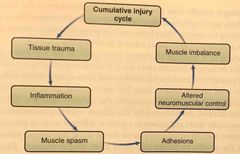
Is a repair process caused when poor posture & repetitive movements create dysfunction within the connective tissue of the body which is treated like an injury. |
|
|
|
Muscles and a constant shortened State (hip flexor musculature when sitting for prolonged periods everyday) It will demonstrate |
Poor NM efficiency (as a result of altered length tension & force couple relationships). |
|
|
|
Heightened activity of muscle spindles in particular areas of the muscle create a |
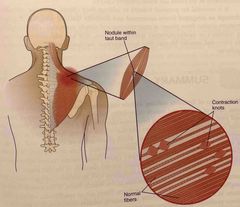
Microspasm, causing adhesions (knots) to begin to form in the soft tissue. |
|
|
|
And inelastic collagen matrix will form along |
The same lines of stress created by altered muscle movements. |
|
|
|
Because the muscle is consistently shortened in the pattern different from its intended function, the new form in elastic connective tissue forms |
Along this altered pattern, reducing the ability to extend and moves in its proper manner. |
|
|
|
What are the 3 phases of integrated flexibility continuum training within the OPT model? |
Collective Active Functional |
|
|
|
Flexibility techniques should only be performed |
Tissues that have been identified as overactive (tight) during the assessment process. |
|
|
|
Correct the flexibility is designed to |
Increase joint ROM Improve muscle imbalances Correct altered joint motion |
|
|
|
And example of synergistic dominance is if the psoas it’s tight, it leads to |
Altered reciprocal inhibition of the gluteus max, increased force output of the synergists for hip extension (hamstring complex, adductor Magnus) to compensate for the weakened gluteus max. |
|
|
|
Corrective exercise includesSelf myofascial release uses the principle |
Self myofascial release Static stretching |
|
|
|
Self myofascial release uses the principle of |
Autogenic in addition to cause muscle relaxation. |
|
|
|
Static stretching can use either |
Autogenic inhibition or reciprocal inhibition to increase muscle length depending on how the stretch is performed. |
|
|
|
Corrective flexibility is appropriate at what level of the OPT model? |
Stabilization level (phase 1) |
|
|
|
At the flexibility uses |
Self myofascial release Active isolated stretching techniques |
|
|
|
Active isolated stretching is designed to improve the |
Extensibility of soft tissue & increase NM efficiency by using reciprocal inhibition. |
|
|
|
Active isolated stretching allows forAnd example of active isolated stretching would be |
Agonists & synergist muscles to move a limb through full ROM while the functional antagonists are being stretched. |
|
|
|
An example of active isolated stretching would be |
A supine straight leg raise. It uses the hip flexors and quadriceps to raise the lake and hold it unsupported, the antagonist hamstring complex is stretched. |
|
|
|
Active flexibility would be appropriate at what level of the OPT model? |
Strength level (phases 2, 3, & 4) |
|
|
|
Self myofascial release techniques Dynamic stretching |
Self myofascial release techniques Dynamic stretching |
|
|
|
The results of synergistic dominance is |
Faulty movement patterns, leading to arthrokinetic dysfunction & eventually injury. |
|
|
|
Dynamic stretching requires |
Integrated, multiplantar soft tissue extensibility, with optional NM control, through full ROM. |
essentially movement without compensations. |
|
|
If a client is compensating when performing dynamic stretches during training, then they need to be |
Regressed to active or corrective flexibility. |
|
|
|
Functional flexibility would be appropriate at what level of the OPT model?Or functional movements occur in |
Power level (phase 5) |
Before athletic competition this would be used. |
|
|
I’ll functional movements occur in |
All 3 planes of motion. |
|
|
|
Transfers |
Transverse |
|
|
|
If the appropriate soft tissue was not extensive all through the fall ROM, the risk of injury |
Dramatically increases. |
|
|
|
The flexibility continuum is a |
Systematic progression |
|
|
|
Arthro-kinetic dysfunction |
Altered forces at the joint that results in abnormal muscular activity & impaired NM communication at the joint. |
|
|
|
Altered joint motion can be caused by |
Altered length tension/force couple relationship couples, affecting the joint and causing poor movement efficiency. |
|
|
|
And example of Arthur Connecticut Passion is performing a squat with excessively externally rotated feet |
This forces the tibia (shin bone) & femur to also rotate externally. |
|
|
|
Mechanoreceptors (sensory receptors) located in the muscles & The hamstring complex is a prime example of tendons help to |
Determine muscle balance or imbalance. |
|
|
|
The hamstring complex is a prime example of the muscle spindles response to lengthening/stretching of a muscle |
The pelvis is rotated anteriorly, meaning the anterior superior iliac spines (front of pelvis) move downward (inferiorly) & the ischium (bottom posterior portion of pelvis, where hamstrings originate) upward superiorly. |
|
|
|
The flexibility continuum is a |

Systematic progression |
|
|
|
Each form of stretching manipulates the |
Receptors of the NS, allowing for alteration of muscle extensibility. |
|
|
|
Examples of stretching within the flexibility continuum |
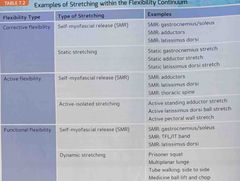
Back (Definition) |
|
|
|
So if my fascial release is a stretching technique that focuses on |
The neural system & fascial system in the body (or the fibrous tissue that surrounds & separates muscle tissue). |
|
|
|
By applying a gentle forced to an adhesion (knot) the elastic muscle fibers are |
Altered from a bundled position (which causes the adhesion) into a straighter alignment with the direction of the muscle/fascia. |
|
|
|
The gentle pressure (foam rolls) will stimulate the |
Gogi tendon organ, creating autogenic inhibition, decreasing muscle spindle excitation, releasing the hypertonicity (tension) of the underlying musculature. |
|
|
|
When using self myofascial release you must find a |
Tender spot (indicating the presence of muscle hypertonicity) & sustain pressure on that spot for a minimum of 30 secs. |
|
|
|
Self myofascial release helps restore The body to its optimal level of function by |
Resetting the proprioceptive mechanisms of the soft tissue. |
|
|
|
SMR : Gastrocnemius/Soleus (calves) |

Back (Definition) |
|
|
|
SMR : Tensor Fascia Latae (TFL)/ Iliotibial Band (IT Band) |

Back (Definition) |
|
|
|
SMR : Adductors |

Back (Definition) |
|
|
|
SMR : Piriformis |

Back (Definition) |
|
|
|
SMR : Latissimus Dorsi |

Back (Definition) |
|
|
|
Static stretching is the process of |
Passably take a muscle to the point of tension and holding the stretch for minimum of 30 secs. |
|
|
|
Static stretching summary : mechanism of action, acute variables, examples : |

Back (Definition) |
|
|
|
Static stretches : gastrocnemius |
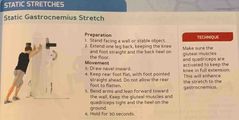
Back (Definition) |
|
|
|
Static stretches : standing TFL |

Back (Definition) |
|
|
|
Static stretches : kneeling hip flexor |
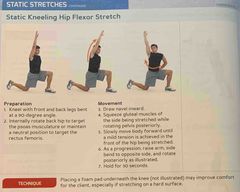
Back (Definition) |
|
|
|
Static stretches : standing adductor |
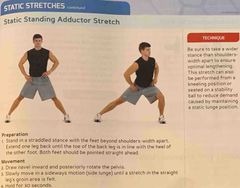
Back (Definition) |
|
|
|
Static stretches : latissimus dorsi ball |
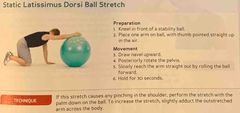
Back (Definition) |
|
|
|
Static stretch : pectoral |
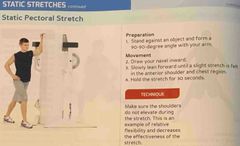
Back (Definition) |
|
|
|
Static stretches : upper trapezius/scalene |
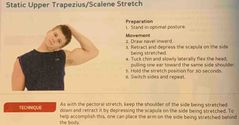
Back (Definition) |
|
|
|
When performing the kneeling hip flexor stretch, an individual can contract the |
Hip extensors (gluteus max) to reciprocally inhibit the hip flexors (psoas, rectus femoris), allowing for greater lengthening of these muscles. |
|
|
|
Active isolated stretching |
The process of using agonists & synergists to dynamically move the joint into a ROM. |
|
|
|
|
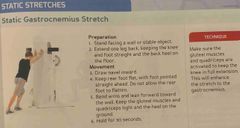
Back (Definition) |
|
|
|
By holding a muscle in a stretch position for prolonged period, |
The cookie tin organ is stimulated producing an inhibitory effect in the muscle spindle (autogenic inhibition). |
|
|
|
Static stretching should be used to decrease |
The muscle spindle activity of a tight muscle before & after activity. |
|
|
|
Active isolated stretching increases motor neuron excitability, creating |
Reciprocal inhibition of the muscle being stretched. |
|
|
|
During the active supine biceps femoris stretch, the quad extends the knee |
Enhancing the stretch of the biceps femoris in 2 ways. 1. Increases the length 2. The contraction of the quad causes reciprocal inhibition of the hamstring complex, allow and gets elongate. |
|
|
|
Active latissimus dorsi ball stretch : |
Back (Definition) |
|
|
|
Active pectoral stretch : |
Back (Definition) |
|
|
|
Active upper trapezius/scalene stretch : |
Back (Definition) |
|
|
|
Active isolated stretching summaryActive isolated stretching is |

Back (Definition) |
|
|
|
Active isolated stretches : Active Gastrocnemius with pronation & supination |

Back (Definition) |
|
|
|
Active supine biceps femoris stretch : |
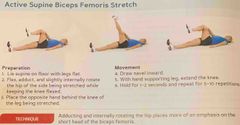
Back (Definition) |
|
|
|
Active standing TFL stretch : |
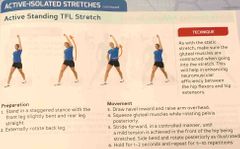
Back (Definition) |
|
|
|
Active kneeling hip flexor stretch : |
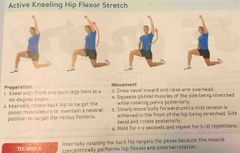
Back (Definition) |
|
|
|
Active standing adductor stretch : |
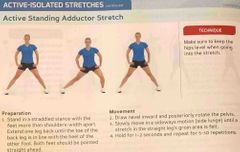
Back (Definition) |
|
|
|
Active latissimus dorsi ball stretch : |
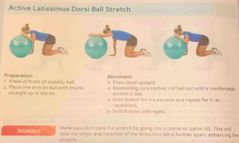
Back (Definition) |
|
|
|
Active pectoral stretch : |
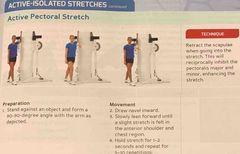
Back (Definition) |
|
|
|
Active upper trapezius/scalene stretch : |
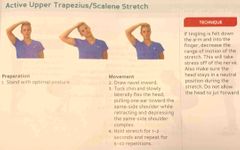
Back (Definition) |
|
|
|
Dynamic stretch : prisoner squat : |
Back (Definition) |
|
|
|
Dynamic stretch : multiplanar lunch with reach : |
Back (Definition) |
|
|
|
Dynamic stretch : single-leg squat touchdown : |
Back (Definition) |
|
|
|
Dynamic stretch : tube walking : side to side : |
Back (Definition) |
|
|
|
Dynamic stretch : Controversy or stretchesmedicine ball lift & chop : |
Back (Definition) |
|
|
|
Controversial stretches : inverted hurdler’s stretch : |
Places high stress on the inside of the knee (medial collateral ligament) & may cause pain & stress on the knee (patella) |
Should not be used by anyone with a history of knee or low back pain. |
|
|
Controversial Stretch : plow : |
The inverted nature of the stretch (head is lower than the hips), this Stretch places high stress on the neck & spine. |
Should not be performed by those with : HBP (hypertension) History of neck or back injury |
|
|
Dynamic stretching summary : mechanism of action, acute variables, examples : |

Back (Definition) |
|
|
|
Dynamic stretch : prisoner squat : |
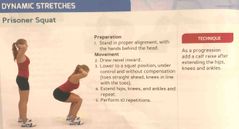
Back (Definition) |
|
|
|
Dynamic stretch : multiplanar lunch with reach : |

Back (Definition) |
|
|
|
Dynamic stretch : single-leg squat touchdown : |
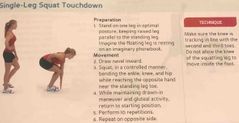
Back (Definition) |
|
|
|
Dynamic stretch : tube walking : side to side : |

Back (Definition) |
|
|
|
Dynamic stretch : Controversy or stretchesmedicine ball lift & chop : |

Back (Definition) |
|
|
|
Controversial stretches : inverted hurdler’s stretch : |

Places high stress on the inside of the knee (medial collateral ligament) & may cause pain & stress on the knee (patella) |
Should not be used by anyone with a history of knee or low back pain. |
|
|
Controversial Stretch : plow : |

The inverted nature of the stretch (head is lower than the hips), this Stretch places high stress on the neck & spine. |
Should not be performed by those with : HBP (hypertension) History of neck or back injury |
|
|
Controversial stretch: shoulder stand : |
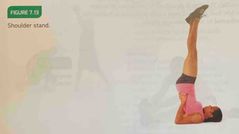
Inverted stretch that places high stress on the neck, shoulders, & spine. |
Should be avoided in patients with : HBP (Hypertension) History of neck or spine injury |
|
|
Controversial stretch : straight leg toe touch : |

One of the most common hamstring complex stretches. This places the vertebrae & cartilage discs in the low back under high stress. |
Should be avoided in clients with : History of herniated disc’s Nerve pain that runs in the back of the leg. Those with poor flexibility may attempt to hyperextend the knees, placing high stress on those ligaments. |
|
|
Controversial stretch : arching quads : |

Design for quads & hip flexors. This place is a very high stress on the knee cap & other tissues on the front of the knee joint. |
Should be avoided in clients with : History of knee injuries |
|
|
Compensations, muscle imbalances, & corrective strategies in the anterior & lateral views : |
Compensations, muscle and balances, & corrective strategies : anterior & lateral views ; |
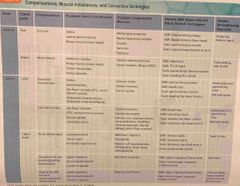
Probable over/under active muscles : SMR & static stretching techniques : |

